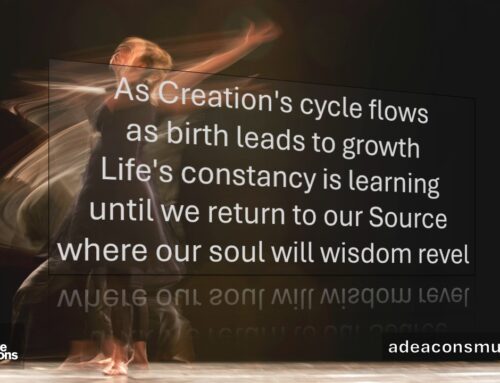Upon shadows’ cusp
we stand
At desert’s edge
we begin
We walk into timeless time
to prepare, reflect
listen & discern
(A Pres-bit|@wpgpres)
Lent means lots of things to many people. There are different Christian understandings and kinds of practice (Church-ese – discipline). I was trying to wrestle what this first Lenten blog (for 2015) would look like, to whom I would be speaking and (ultimately) what the intention would be? Then it occurred to me – perhaps I was reminded – that the entire concept of Lent is pretty foreign to the secular world in which the church finds itself. And – rather than worry or bemoan this (Lament in Church-ese) – it occurred to me that I might take this as an opportunity to explore and share how Lent might actually speak to the world outside of a faith-based environment. And – this won’t come as surprise to regulars of A Deacon’s Musing – often when we talk to the Other, we actually find we may very well be speaking to ourselves …
So, how do I share what Lent might mean for someone for whom the concept is totally new? I’ve already provided the link to Wikipedia (above and below). If it’s simply information that might be needed to explain it, I humbly recognise that’s likely a much better resource. In fact, just Google Lent … no doubt one could read for a very long time and still not exhaust the amount of data that’s out there in the land of cyber …
But what I thought I might offer – as way of sharing my own appreciation – is by using an image: shadows. We walk – throughout lives – in the midst of light and shadows: sometimes at the same time! I think of light as the good stuff. For what I’m grateful. The people and events that make me laugh – the creatures and days that lead me to marvel and wonder. It may not always be easy, but there’s a simplicity when in the light. And – rather than create a ‘one’s better than the other’ – light can also seem uncompromising, perhaps even harsh if we see it as one way to reinforce ‘right = light’ and ‘wrong = shadows.’
Shadows are often not easy and (too often) definitely not simple. From the realities of aging to living, dying often unfolds in shadow spaces. Pain and sorrow too. There’s no doubt that what often gets broadcast through traditional media is shadow-laced. Violence, war, and dignity violations of the soul-wrenching kind. This is only more difficult when there’s a constant sense of guilt around the environment, consumerism, feelings of inadequacy and powerlessness … To be clear, however, being in the midst of shadows is not necessarily ‘bad,’ but it is also a place and space in which it is difficult to shine.
Light dances through shadows, but sometimes when we’re in the places where grey-monotone dominates, it’s hard to see the path illuminated before us. And – the connexion with Lent – is that it is part of the Christian calendar in which we intentionally sit in the shadows, sort of like in exile. It’s the place we ask tough questions, often looking into the mirror with discomfort. It’s certainly not an easy 40 days!
The reason 40 is important is that – for Christians – that is the amount of time Jesus (the one whom we endeavour to follow and model) was in the desert. It’s also a time of old pedigree in the larger Jewish story (in which Christianity is intimately rooted) about wandering and doubting, questioning and even raging against one another, though ultimately at God. Lent then makes space for those questions and longings that we all have. In faith-based contexts then, such searching is not only encouraged, but time is set aside for it. Particular to the Christian calendar, one stretch of time where (with intention) we make space is Lent.
Dwelling in the shadows is never easy, and far from simple. Being in their midst, the clarity of what’s right or wrong gets blurred. Certainty of values and beliefs can become skewed. But if we do not make space for such practice – this is the Christian experience talking – then when that proverbial fan gets hit, we’ve at least done some preparation. Doesn’t mean we’re ready for those unexpected trials (whether that’s death, dis-ease, financial concerns and/or violence: to mention only a few things that lead into shadows), but we have nurtured some resilience, some capacity to remain clear on what’s important in the inevitable moments of anxiousness and – even – fear.
Light and shadows dance … the gift that Lent presents is being able to see the path illuminated even when all seems shaded-grey …









Your reflections are most welcome!